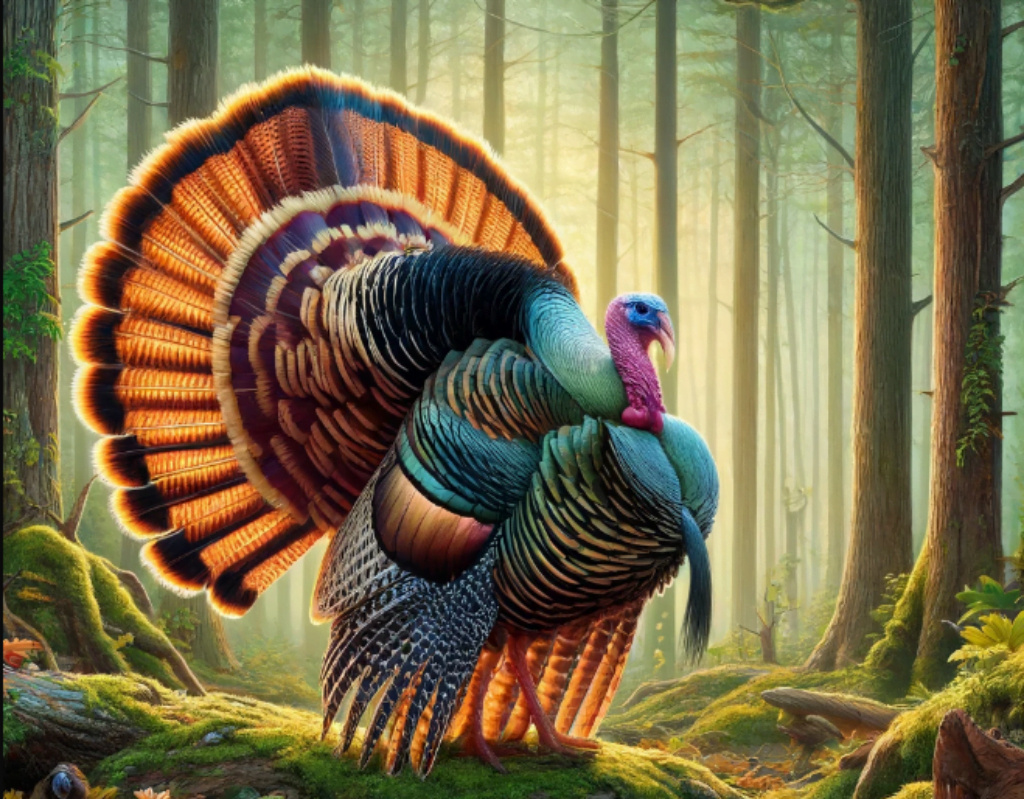The Ultimate Guide to Wild Turkey Sounds


Wild turkeys are fascinating creatures known for their distinctive vocalizations. Understanding these sounds can enhance your turkey hunting experience or simply deepen your appreciation for these magnificent birds. This comprehensive guide explores the various sounds wild turkeys make, their meanings, and how you can use this knowledge to your advantage.
Table of Contents
Introduction to Wild Turkey Sounds
Wild turkeys are not just known for their impressive size and fan-like tail feathers but also for their vocalizations. These sounds play a crucial role in their communication and can be key to successful turkey hunting. By learning and understanding these sounds, you can become more adept at locating and attracting turkeys.
Types of Wild Turkey Sounds
Wild turkeys produce a variety of sounds, each with its own unique purpose and meaning. Let’s delve into the most common turkey vocalizations.
Gobble
The gobble is perhaps the most well-known turkey sound. This loud, rapid gurgling noise is made primarily by male turkeys, known as gobblers, especially during the breeding season. The gobble serves to announce the gobbler’s presence and attract hens.
Cluck
Clucks are short, soft notes used by both males and females. They often signify contentment and can also serve as an alarm call when turkeys sense danger.
Purr
Purring is a soft, rolling sound that indicates contentment and relaxation. It is often heard when turkeys are feeding. If a purr turns into a louder, more aggressive noise, it can signify agitation or a minor conflict among the flock.
Yelp
Yelps are series of single-note calls that turkeys use to communicate with each other. Hens use yelps to attract gobblers during the mating season. The rhythm and intensity of yelps can vary, conveying different messages.
Cutt
Cutting is a series of loud, fast, and sharp clucks. This sound often indicates excitement or agitation and is frequently heard during courtship or when a turkey is searching for others.
Kee Kee Run
The kee kee run is a high-pitched call made by young turkeys, or poults, particularly when they are lost and trying to locate the flock. It consists of a series of “kee kee” notes followed by a series of yelps.
Tree Call
Tree calls are soft yelps and clucks made by turkeys while they are roosting in trees. These calls occur primarily in the early morning as turkeys begin to wake up and prepare to leave the roost.
The Importance of Turkey Sounds in Hunting
Understanding and mimicking turkey sounds is a vital skill for any turkey hunter. By effectively using calls, hunters can attract turkeys to their location, increasing their chances of a successful hunt. Different calls can be used to simulate the presence of a turkey flock, a lone hen, or even a rival gobbler, each with its own strategic advantage.
How to Mimic Wild Turkey Sounds
Successfully mimicking turkey sounds requires practice and the right tools. Here are some tips to help you get started:
- Use Quality Calls: Invest in high-quality turkey calls, such as box calls, slate calls, and diaphragm calls. Each type has its own unique sound and is suited to different situations.
- Practice Regularly: Practice makes perfect. Spend time listening to recordings of real turkey sounds and practice replicating them.
- Learn the Cadence: The rhythm and cadence of turkey calls are crucial. Pay attention to the spacing and length of each note.
- Adapt to the Situation: Different situations call for different sounds. Learn to read the behavior of turkeys and adjust your calls accordingly.
Advanced Techniques for Mimicking Wild Turkey Sounds
Now that we’ve covered the basics of turkey vocalizations, let’s dive into some advanced techniques and tips to help you master the art of turkey calling.
Understanding Turkey Behavior
Understanding the behavior of wild turkeys can give you an edge in calling them effectively. Here are some key behaviors to observe:
- Breeding Season: During the spring, gobblers are highly vocal and responsive to hen calls. This is the prime time for using yelps and cuts.
- Feeding Patterns: Turkeys have regular feeding times. Using clucks and purrs during these times can simulate feeding turkeys and attract a flock.
- Roosting Habits: Knowing where turkeys roost can help you set up your calls strategically. Use tree calls in the early morning to simulate turkeys waking up and getting ready to fly down.
Types of Turkey Calls
There are several types of turkey calls available, each with its own advantages and best-use scenarios:
Box Calls
Box calls are one of the easiest types of calls to use. They consist of a wooden box with a paddle that creates friction to produce sound. Box calls are excellent for producing loud, resonant yelps, clucks, and cuts.
Pros: Easy to use, great for beginners, loud volume. Cons: Bulky to carry, not ideal for soft, subtle calls.
Slate Calls
Slate calls, also known as pot calls, use a slate surface and a striker to create sounds. They are versatile and can produce a wide range of turkey vocalizations.
Pros: Versatile, great for soft and loud calls, realistic sound. Cons: Require practice to master, can be affected by moisture.
Diaphragm Calls
Diaphragm calls, or mouth calls, consist of a flexible frame with latex reeds that you place in your mouth. By manipulating airflow and tongue pressure, you can produce a variety of turkey sounds.
Pros: Hands-free operation, versatile, lightweight. Cons: Steeper learning curve, requires regular cleaning.
Calling Strategies
Early Morning Strategy
During the early morning, as turkeys wake up, use soft tree yelps and clucks to simulate a turkey waking up. As the sun rises, increase the intensity of your calls with more yelps and even a gobble to attract attention.
Midday Strategy
Midday hunting can be challenging as turkeys are less vocal. Use subtle calls like purrs and soft clucks to mimic feeding turkeys and lure in gobblers looking for hens.
Evening Strategy
As turkeys prepare to roost in the evening, use assembly yelps to simulate a hen gathering the flock. This can be particularly effective in drawing in turkeys looking for a roosting spot.
Tips for Effective Turkey Calling
- Stay Still and Quiet: Turkeys have excellent eyesight and can detect movement easily. Stay still and minimize unnecessary noise while calling.
- Use Cover: Set up your calling position with good cover to remain hidden from the turkeys’ sharp eyes.
- Be Patient: Sometimes, it takes a while for turkeys to respond to calls. Be patient and persistent.
- Mix Up Your Calls: Don’t rely on one type of call. Mix up yelps, clucks, and purrs to keep things interesting and realistic.
- Practice Makes Perfect: Regular practice is key to mastering turkey calls. Use recordings of real turkeys to refine your technique.
Common Mistakes in Turkey Calling and How to Avoid Them
Even experienced hunters can make mistakes when calling turkeys. Here are some common pitfalls and how to avoid them:
Overcalling
One of the most common mistakes is overcalling. Too much calling can make turkeys suspicious. It’s essential to strike a balance and avoid being overly aggressive with your calls.
Tip: Use calls sparingly and listen for responses. If turkeys are responding, reduce the frequency of your calls to maintain their interest.
Incorrect Cadence
The rhythm and cadence of your calls are crucial. Incorrect timing can make your calls sound unnatural and ineffective.
Tip: Listen to recordings of real turkeys and practice matching their cadence. Pay attention to the spacing and rhythm of each call.
Ignoring Wind Conditions
Wind can carry your calls in unintended directions or muffle them, making it difficult for turkeys to hear you.
Tip: Adjust your calling strategy based on wind conditions. Use louder calls in windy conditions and position yourself where the wind carries your call towards the turkeys.
Calling from the Open
Calling from an open area makes you more visible to turkeys, reducing your chances of success.
Tip: Always call from a concealed position. Use natural cover like trees, bushes, or camouflage to blend into your surroundings.
Impatience
Impatience can lead to frequent movement and noise, which can scare off turkeys.
Tip: Be patient and stay still. Allow time for turkeys to respond to your calls and approach your location.
Frequently Asked Questions
What is the best time to hear turkeys gobble?
The best time to hear turkeys gobble is during the early morning hours, just before and after sunrise. This is when gobblers are most active and vocal.
Can female turkeys gobble?
While it’s rare, female turkeys, or hens, can gobble. However, their gobble is usually less pronounced and less frequent than that of male turkeys.
How far can a turkey gobble be heard?
A turkey gobble can be heard up to a mile away in optimal conditions, such as in open terrain with little background noise.
Do turkeys make noise at night?
Turkeys are generally quiet at night. They roost in trees and may make occasional soft clucks or purrs, but they do not gobble at night.
How do I know which turkey call to use?
The type of call you use depends on the situation. For example, use yelps and clucks to attract hens and gobblers during the mating season, and use purrs and soft clucks when trying to calm and reassure turkeys.
Conclusion
Understanding wild turkey sounds can significantly enhance your turkey hunting experience or simply your appreciation for these intriguing birds. By learning to identify and mimic these sounds, you can improve your chances of successful turkey encounters. Whether you’re a seasoned hunter or a nature enthusiast, the world of wild turkey vocalizations is fascinating and rewarding to explore.







